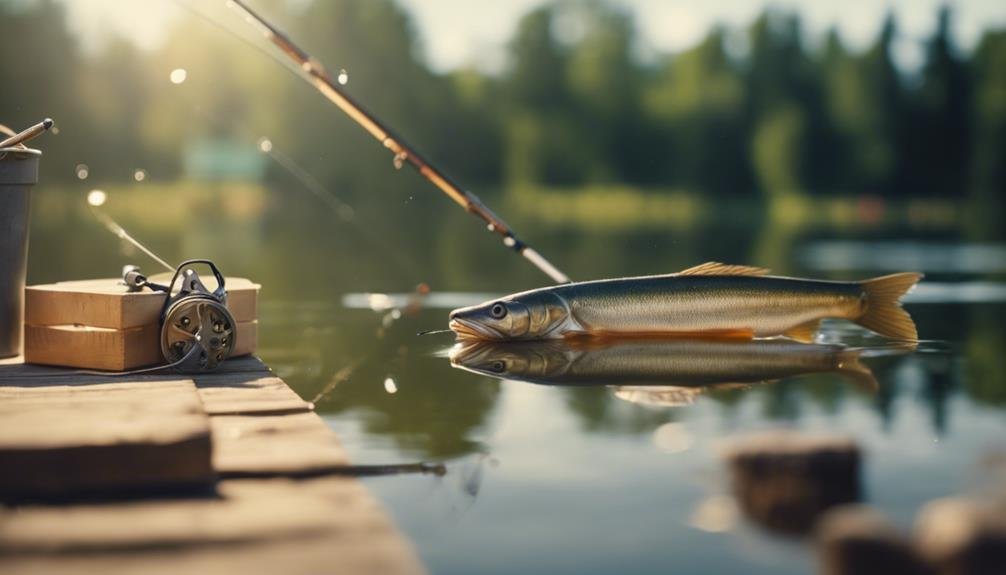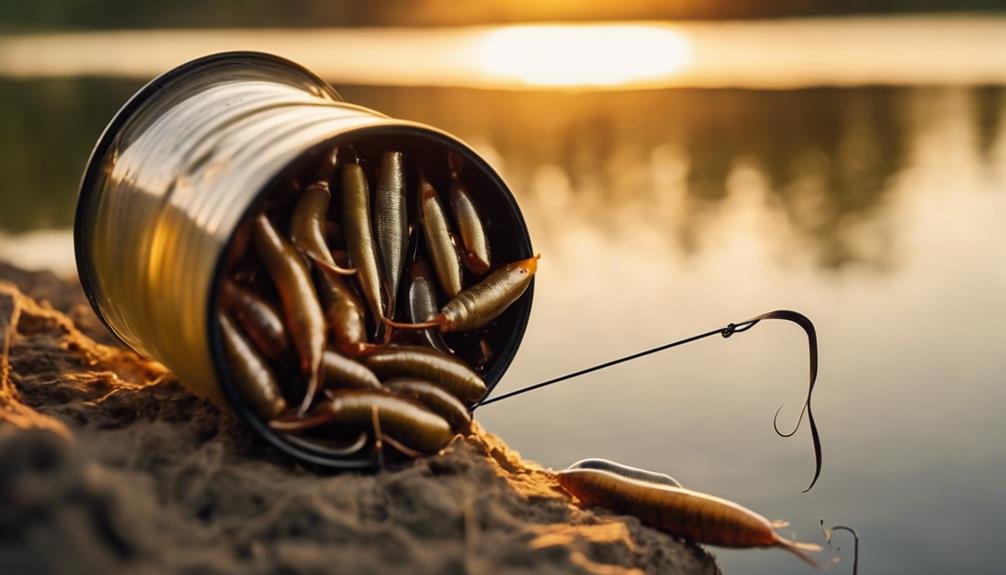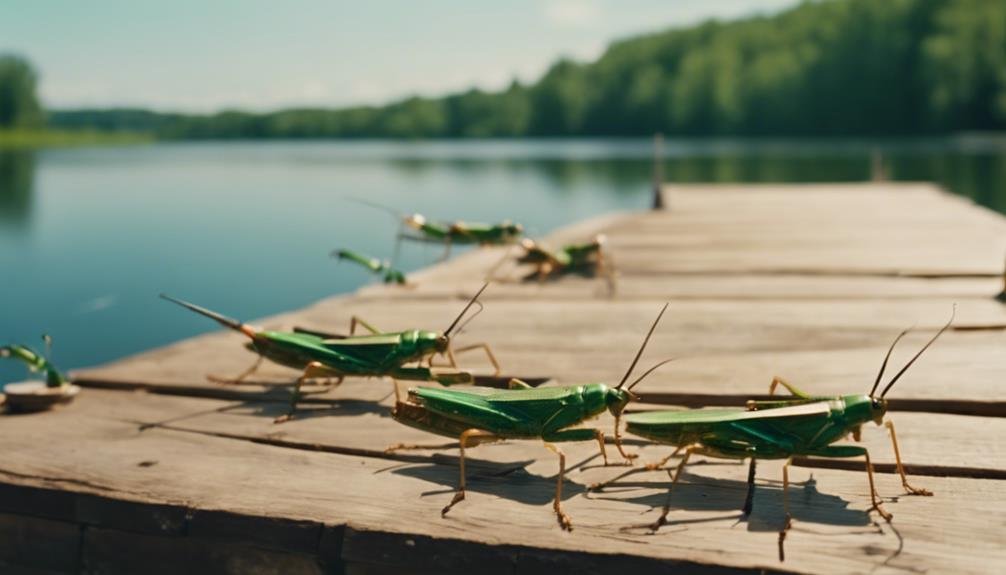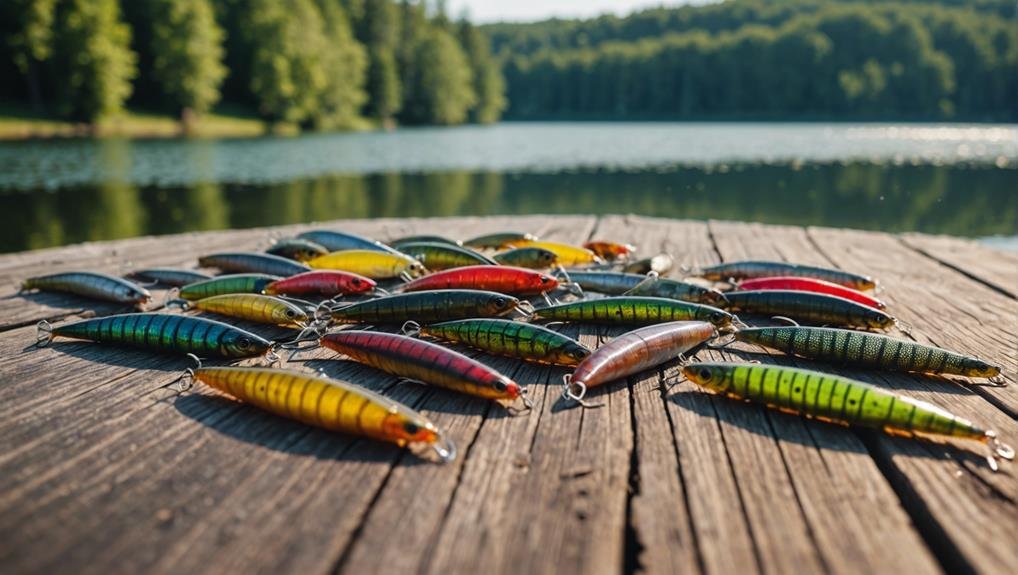When selecting the best fishing bait, it’s important to consider the target species and fishing conditions. You might wonder if live bait like worms, minnows, or crayfish will give you an edge or if artificial lures like spinners, jigs, and flies could be more effective. Each option has advantages, and understanding how these baits mimic natural prey can substantially increase your catch. Additionally, everyday grocery items like bread and chicken livers shouldn’t be overlooked. So, which bait truly reigns supreme? Explore the nuances that could make or break your next fishing trip.
Key Takeaways
- Worms and nightcrawlers are excellent for attracting bottom-feeding species and are especially effective for Walleye.
- Minnows are versatile and reliable. They are. They are ideal for crappie, bass, and trout and should be kept fresh with an Aerator system.
- Crayfish, when tail-hooked, are enticing bait for bass, catfish, and big trout, but check local regulations before use.
- Artificial baits like spinners and jigs are effective in various water conditions, with spinners offering flash and vibration for murky waters.
- Due to their scent and texture, grocery store baits like chicken livers and tilapia chunks are highly effective in attracting catfish.
Live Bait Options
Worms, crickets, and grasshoppers are popular choices for freshwater fishing. These baits are easy to find and effective in luring various fish species.
Minnows, another excellent live bait option, are particularly effective for catching larger fish. They mimic the natural prey of many freshwater species, ensuring your fishing trip is productive. Crickets and grasshoppers are also great for enticing fish, especially in environments where these insects are common.
For saltwater fishing, your options include sea worms, eels, crabs, shrimp, squid strips, and fish pieces. These saltwater fishing baits are highly effective in attracting many marine species.
Keeping your live bait alive and casting it gently guarantees it will remain effective on the hook. Selecting the right bait for your specific fishing conditions is important for achieving success in your angling endeavors.
Worms and Nightcrawlers
Many anglers find worms and nightcrawlers the most effective bait for various fish species. Nightcrawlers, particularly, are a favorite for Walleye fishing due to their ability to attract this species. Their size and movement make them highly visible and appealing to Walleye.
When fishing in shallow waters, using large-sized worms can be especially beneficial. These worms are versatile bait options that can be rigged in various ways to target different fish species.
Worms are excellent for attracting bottom-feeding species. Their natural juice acts as a Walleye fishing, drawing fish from a distance. When you present worms along the lake bottom, you create an irresistible scenario for fish that feed there.
The key to maximizing their effectiveness is a natural presentation. Ensure your bait looks and moves as it would in the wild, enhancing its appeal.
Using Minnows

Live minnows are a bait for targeting crappie, bass, and trout due to their lifelike movement and appeal. Their natural swimming motion is irresistible to these freshwater species, making them one of the most effective baits you can use.
Proper hooking is the key to success with live minnows when you’re out on the water. Hooking them through the back or lips helps maintain their natural appeal and guarantees they swim enticingly.
You can easily purchase live minnows from local tackle shops. Invest in a small aerator system to keep your bait fresh and lively. This will keep the water oxygenated, ensuring your minnows remain active and attractive to fish. Minnows come in various sizes, and small to medium ones are particularly effective for catching crappie and trout, while larger minnows can tempt bigger bass.
Using live minnows offers a versatile and reliable fishing option. Whether you’re targeting crappie in a quiet pond, bass in a bustling lake, or trout in a clear stream, minnows provide a natural appeal that fish can’t resist.
Ensure they’re well-hooked and lively, and you’ll increase your chances of a successful catch.
Crayfish for Fishing
Crayfish offers an enticing and effective bait option for anglers targeting bass, catfish bait, and big trout. Their natural appeal makes them a favorite among these fish species. To maximize their effectiveness, you should use the tailhook method, which involves hooking the crayfish through the tail. This technique keeps them alive longer, making them more attractive to fish.
Before heading out, check local regulations regarding using crayfish as bait. Some areas have restrictions to protect local ecosystems and promote sustainable fishing practices. Ignoring these rules can lead to fines or other penalties, so staying informed is important.
Crayfish are a productive bait, especially when targeting specific fish species like bass, catfish, and trout. Keeping your crayfish alive and fresh is essential. Store them in a cool, aerated container and avoid overcrowding. Fresh, lively crayfish are more likely to attract fish, enhancing your chances of a successful catch.
Leeches for Walleye

Switching from crayfish, leeches are another top-tier bait choice, especially effective for catching Walleye. Leeches are prized for their natural movement and scent, making them irresistible to Walleye in various water conditions. When using sponges as live bait, proper hooking is important. You’ll want to hook them through the sucker to maintain their lifelike presentation, which greatly enhances their effectiveness.
Maintaining the freshness of your leeches is essential. Regularly changing the water they’re stored in can help keep them lively and appealing to Walleye. Fresh leeches exhibit more natural movement, an important factor that draws in fish. Clear water conditions are ideal for sponges, as their movement is more visible to Walleye, increasing your chances of a successful catch.
Before heading out, familiarize yourself with local regulations regarding using live bait. Some areas may have restrictions or specific guidelines you need to follow. By understanding these rules, you’ll ensure you’re fishing legally and responsibly.
To summarize, leeches are a highly effective choice for catching Walleye, provided you care for their hooking, maintenance, and adherence to local laws.
Ice Fishing Baits
When it comes to ice fishing, choosing the right bait can greatly increase your chances of a successful catch. Ice fishing baits like waxworms, mousies, spikes, and minnows are popular among anglers. These live baits are particularly effective because they mimic fish’s natural prey under the ice.
Artificial baits like jigs, spoons, and soft plastics also perform well in cold waters. These baits can be enhanced with scented baits to attract fish, especially in the limited visibility conditions often encountered during ice fishing. Ensuring your live bait doesn’t freeze is essential, so keep them in insulated containers.
Here’s a quick guide to popular ice-fishing baits:
| Live Bait | Artificial Bait |
|---|---|
| Waxworms | Jigs |
| Mousies | Spoons |
| Spikes | Soft Plastics |
| Minnows | Scented Baits |
Small, natural baits like maggots are excellent for targeting panfish through the ice. Each bait type has unique advantages; sometimes, combining different kinds can yield the best results. Don’t hesitate to experiment with various ice fishing baits to find what works best for you on any given day.
Crickets and Grasshoppers

Why not use crickets and grasshoppers as your go-to live bait for attracting freshwater fish like bluegill and trout? These insects aren’t only effective but also offer anglers a versatile option.
Regarding freshwater fishing, crickets are particularly useful in shallow waters or along the lake’s edge, making them ideal for targeting panfish like bluegill. Their natural movement in the water mimics real prey, enticing fish to bite.
Grasshoppers, on the other hand, can attract a wide variety of fish species. Their larger size and more noticeable movements make them particularly appealing to trout. These insects are especially productive in freshwater environments, where their natural hopping and fluttering can draw fish from a distance. Anglers often find that using grasshoppers results in more engaging and successful fishing sessions.
Both crickets and grasshoppers are top choices for live bait because they offer the natural movement fish find irresistible. Whether fishing in a calm lake or a bustling river, these insects can help you catch more fish.
Best Artificial Baits
While live bait like crickets and grasshoppers are effective, artificial baits offer a durable and versatile alternative for attracting a wide range of fish species. Artificial baits, such as spinners, jigs, poppers, flies, and spoons, are designed to mimic natural food sources like minnows or mayflies. They come in various sizes and styles, giving you the control to match your lure to the specific fish you’re targeting and the conditions you’re fishing in.
Spinners are great for their flash and vibration, attracting fish in murky waters. Jigs, on the other hand, are versatile and can be used in both freshwater and saltwater. Poppers are ideal for topwater action, creating a splash that draws fish to the surface. Flies are perfect for fly fishing, imitating insects that fish naturally feed on. Spoons have a wobbling action that resembles an injured fish, making them irresistible to predators.
Experimenting with different colors, sizes, and actions of these artificial baits can significantly enhance your effectiveness. Don’t forget to read the instructions on lure packages to maximize their potential. With artificial baits, durability, and reusability mean you’ll spend more time fishing and less time rebaiting.
Grocery Store Baits

Grocery store baits like white bread, corn, and marshmallows are budget-friendly and surprisingly effective for catching various fish species. These easily accessible items make fishing more convenient and cost-effective, especially when small bait shops are hard to find.
White bread, for instance, can be molded into small balls that attract a variety of fish, while corn is particularly effective for species like carp. Marshmallows, with their bright color and buoyancy, can lure fish such as trout.
Expanding your bait options, grocery store baits like tilapia, Velveeta, and chicken livers offer versatility for targeting different types of fish. Tilapia chunks work well for catfish, while the rich scent and texture of chicken livers are also favorites of catfish. With its strong odor and easy moldability, Velveeta can attract fish like bluegill and catfish.
Using grocery store bait isn’t only cost-effective but also a practical choice when you’re looking to experiment with different types of bait without breaking the bank. With a little creativity, the variety of grocery store baits available can greatly enhance your fishing experience.
Conclusion
Choosing the best fishing bait depends on your target fish and your fishing conditions. Whether you’re using live bait like worms and minnows or artificial lures such as spinners and jigs, the key is matching your bait to the situation.
For a simple yet effective approach, don’t overlook grocery store options like bread and chicken livers. Remember, the best bait is the one that gets the fish biting.
Happy fishing!

